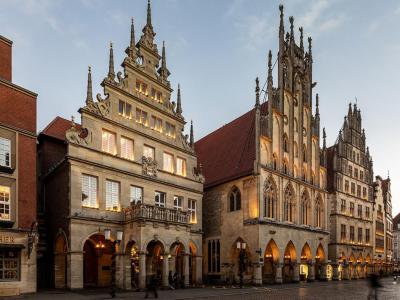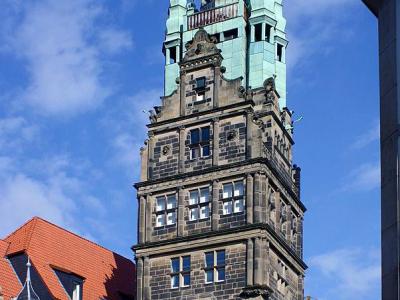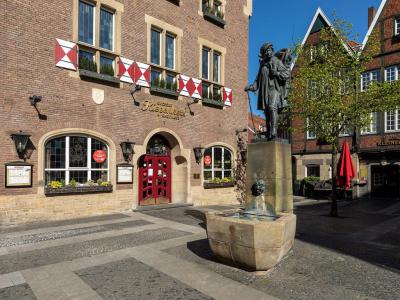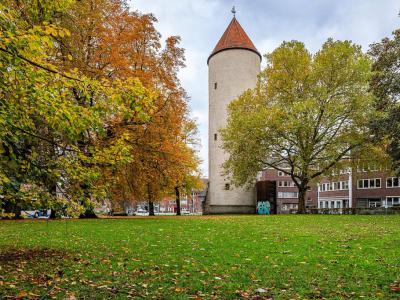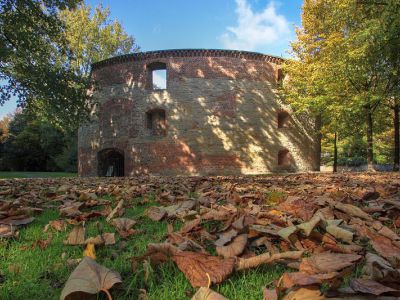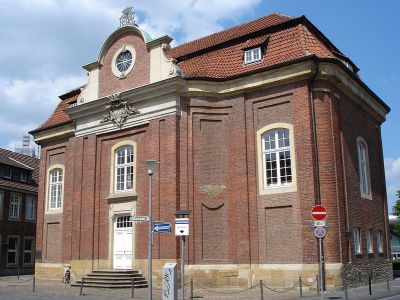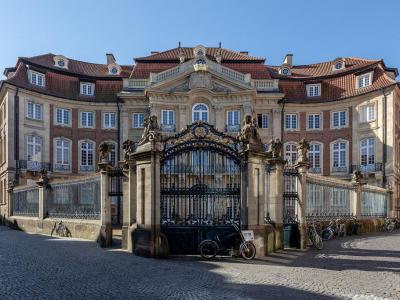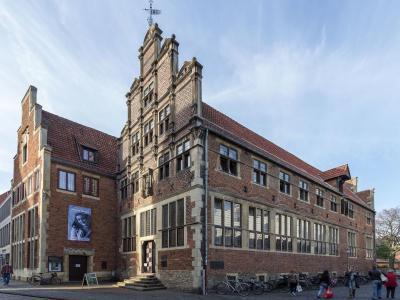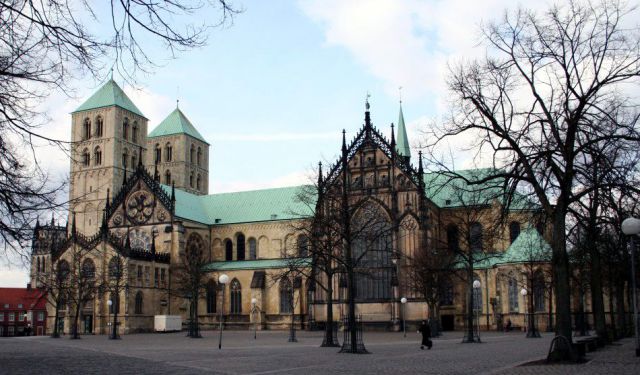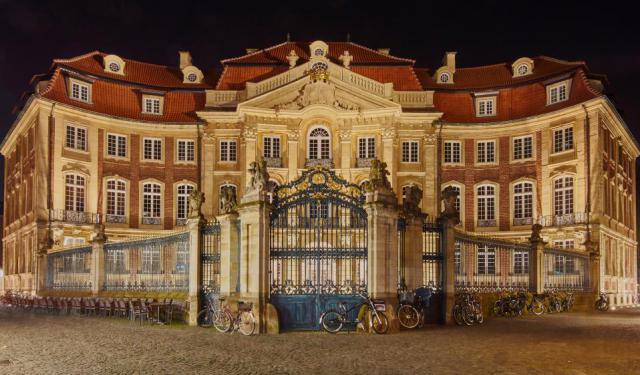
Munster's Historical Buildings Walking Tour (Self Guided), Munster
The centuries-long history of Munster, set in stone, is still very much alive. The carefully restored ancient homes, churches, and other – sometimes peculiar – pieces of architecture, abounding the city, “tell” the tales of its past rather eloquently, all the while setting a stage that makes every visit to Munster an exciting experience.
The reconstruction of the local Old Town, contrary to that of many other German cities destroyed during WWII, followed the original cityscape, preserving almost fully (in their medieval entirety) the promenade ring and the charming Prinzipalmarkt street.
The latter, one of the oldest thoroughfares in the city, not widened after the war, is still lined with numerous gabled houses joined together by an arcade. Many of these buildings were created by Johann Conrad Schlaun, including the landmark Town Hall (1767-1773) and the Erbdrostenhof palace (1755), often regarded as his masterpiece.
Among other historical structures of note is the Zwinger tower, located on the promenade since 1528, formerly used as a prison and now housing a memorial. Another one, also on the promenade (in its northern part), is the Buddenturm tower, a remnant of the 12th-century city fortifications. The Krameramtshaus, built in 1589, is one of the oldest guild houses in Münster, well worth checking out as well.
The majority of the architecturally-important locations of Münster are comfortably located within a walking distance from each other and, thus, can be easily reached on foot, especially by those armed with the self-guided GPSmyCity app. If you still haven't got one, consider adding it to your mobile as soon as possible and explore the city without getting lost!
The reconstruction of the local Old Town, contrary to that of many other German cities destroyed during WWII, followed the original cityscape, preserving almost fully (in their medieval entirety) the promenade ring and the charming Prinzipalmarkt street.
The latter, one of the oldest thoroughfares in the city, not widened after the war, is still lined with numerous gabled houses joined together by an arcade. Many of these buildings were created by Johann Conrad Schlaun, including the landmark Town Hall (1767-1773) and the Erbdrostenhof palace (1755), often regarded as his masterpiece.
Among other historical structures of note is the Zwinger tower, located on the promenade since 1528, formerly used as a prison and now housing a memorial. Another one, also on the promenade (in its northern part), is the Buddenturm tower, a remnant of the 12th-century city fortifications. The Krameramtshaus, built in 1589, is one of the oldest guild houses in Münster, well worth checking out as well.
The majority of the architecturally-important locations of Münster are comfortably located within a walking distance from each other and, thus, can be easily reached on foot, especially by those armed with the self-guided GPSmyCity app. If you still haven't got one, consider adding it to your mobile as soon as possible and explore the city without getting lost!
How it works: Download the app "GPSmyCity: Walks in 1K+ Cities" from Apple App Store or Google Play Store to your mobile phone or tablet. The app turns your mobile device into a personal tour guide and its built-in GPS navigation functions guide you from one tour stop to next. The app works offline, so no data plan is needed when traveling abroad.
Munster's Historical Buildings Walking Tour Map
Guide Name: Munster's Historical Buildings Walking Tour
Guide Location: Germany » Munster (See other walking tours in Munster)
Guide Type: Self-guided Walking Tour (Sightseeing)
# of Attractions: 8
Tour Duration: 2 Hour(s)
Travel Distance: 2.8 Km or 1.7 Miles
Author: Xena
Sight(s) Featured in This Guide:
Guide Location: Germany » Munster (See other walking tours in Munster)
Guide Type: Self-guided Walking Tour (Sightseeing)
# of Attractions: 8
Tour Duration: 2 Hour(s)
Travel Distance: 2.8 Km or 1.7 Miles
Author: Xena
Sight(s) Featured in This Guide:
- Historical City Hall of Münster
- Stadthausturm Münster (Town Hall Tower)
- Kiepenkerl Denkmal (Traveling Merchant Statue)
- Buddenturm
- Zwinger
- Lotharinger Chorfrauenkirche
- Erbdrostenhof
- Krameramtshaus (Grocers' Guild House)
1) Historical City Hall of Münster (must see)
Situated along Principal Market (Prinzipalmarkt), the city's central marketplace and shopping district is the Historical City Hall of Münster (Historisches Rathaus Münster). The building gained fame as the location used for the peace negotiations in 1648 that ended the Thirty Years' War in Europe and the Eighty Years' War, also known as the Dutch Revolt. The council chamber of this historic town hall is known as the Hall of Peace (Friedenssaal).
The building is estimated to date from the 14th century. Its sandstone facade features a stunning Gothic-style design. The structure's layout splits into three levels as arcade floor, the main floor, and the gable floor. The front boasts a lovely arched colonnade. The building's eye-catching Gothic gable is highly ornate and can't be missed while roaming through Principal Market.
This town hall now operates as a museum in the historical Peace Hall. The council chamber walls where the peace treaties were signed are decorated with ornately carved wood paneling. A small figure of Jesus on the cross is mounted behind the judge's table. There are wall portraits and an elaborate chandelier in the room. Inside a glass display case is the famous 17th-century "Golden Cockerel," a gilded silver wine goblet in the shape of a rooster.
The museum includes historical weapons and suits of armor. You'll find a rather eclectic collection of artifacts on display, including a decoratively engraved fireplace and chimney replica, 16th-century bench seat cushions, a doorkeeper's staff, and a 17th-century woman's slipper. The oddest is a small oak box topped with an actual severed hand, origin unknown!
The building was seriously damaged when it was hit by bombs during World War II and soon underwent a complete restoration. A full reconstruction of its original appearance didn't begin until 1950 and took most of the decade to complete. This significant historical landmark is a must-see during your tour of Munster.
The building is estimated to date from the 14th century. Its sandstone facade features a stunning Gothic-style design. The structure's layout splits into three levels as arcade floor, the main floor, and the gable floor. The front boasts a lovely arched colonnade. The building's eye-catching Gothic gable is highly ornate and can't be missed while roaming through Principal Market.
This town hall now operates as a museum in the historical Peace Hall. The council chamber walls where the peace treaties were signed are decorated with ornately carved wood paneling. A small figure of Jesus on the cross is mounted behind the judge's table. There are wall portraits and an elaborate chandelier in the room. Inside a glass display case is the famous 17th-century "Golden Cockerel," a gilded silver wine goblet in the shape of a rooster.
The museum includes historical weapons and suits of armor. You'll find a rather eclectic collection of artifacts on display, including a decoratively engraved fireplace and chimney replica, 16th-century bench seat cushions, a doorkeeper's staff, and a 17th-century woman's slipper. The oddest is a small oak box topped with an actual severed hand, origin unknown!
The building was seriously damaged when it was hit by bombs during World War II and soon underwent a complete restoration. A full reconstruction of its original appearance didn't begin until 1950 and took most of the decade to complete. This significant historical landmark is a must-see during your tour of Munster.
2) Stadthausturm Münster (Town Hall Tower)
The Stadthausturm (Town Hall Tower) is the only remaining part of the former Stadthaus (Town Hall) of Münster that was once located at the southern end of Prinzipalmarkt (Main Market) Street. Unlike the Town Hall building itself, the tower is not a medieval structure and was created only in the early 20th century. It was designed by the German architect Alfred Hensen, featuring Neo-Renaissance style, and built between 1902 and 1907.
Prior to that, this site was occupied by a pharmacy (Löwenapotheke) and a couple of 16th-century warehouses – the Stadtlegge (for linen) and the Stadtkeller (for hop beers), which were purposely demolished to clear space for the tower construction. Back in the early days of the tower, for a while, its basement was used as a mechanical telephone exchange.
The Town Hall building was destroyed on October 28, 1944, in an allied bombing raid during World War II, but the tower miraculously survived almost unscathed.
In 2001, an automatic bell ringing system (glockenspiel) was installed in the tower, co-funded by the Münster Savings Bank, the Münster City Council, and the Nonhoff family. The bell rings three times a day – at 11 am, 3 pm, and 7 pm – playing, depending on the season, either the “Keine schöner Land” tune (from June to August) or some Christmas carols, like “Now rejoice, you Christians”, from November 27th to January 6th.
Prior to that, this site was occupied by a pharmacy (Löwenapotheke) and a couple of 16th-century warehouses – the Stadtlegge (for linen) and the Stadtkeller (for hop beers), which were purposely demolished to clear space for the tower construction. Back in the early days of the tower, for a while, its basement was used as a mechanical telephone exchange.
The Town Hall building was destroyed on October 28, 1944, in an allied bombing raid during World War II, but the tower miraculously survived almost unscathed.
In 2001, an automatic bell ringing system (glockenspiel) was installed in the tower, co-funded by the Münster Savings Bank, the Münster City Council, and the Nonhoff family. The bell rings three times a day – at 11 am, 3 pm, and 7 pm – playing, depending on the season, either the “Keine schöner Land” tune (from June to August) or some Christmas carols, like “Now rejoice, you Christians”, from November 27th to January 6th.
3) Kiepenkerl Denkmal (Traveling Merchant Statue)
The bronze statue of a traveling merchant with a wooden stick and a pannier backpack (historically known as Kiepenkerl), located in Spiekerhof shopping street, lends its name to the whole neighborhood of Kiepenkerlviertel in the Old Town of Münster.
Kiepenkerle is the common term for peddlers in the Low German-speaking area (between Sauerland and Hamburg), who, in the old days, traded in salt and other goods in return for food. The name derives from the Kiepe, a wicker basket, with which the Kiepenkerle walked across the country on their business.
The original monument, made of plaster with a copper coating, was created by sculptor August Schmiemann and installed in 1896. The sculpture depicted a tradesman with his Kiepe, dressed in the typical outfit of the day: linen smock, scarf, cap, with a walking stick and a whistle.
The monument remained intact after the allied air raids on Münster in 1943 and was even used by the Nazi propaganda in 1944 as a symbol of stoicism, featured in a poster that said: "Nevertheless and nevertheless – Where is almost!". When the US Army invaded the city, though, the statue was destroyed by a tank.
Immediately after the war, a competition was launched to recreate the statue. The winner – sculptor Albert Mazzotti Jr. – was commissioned to cast a bronze copy true to the original. The new statue was inaugurated on September 20, 1953, by the then Federal President of West Germany, Theodor Heuss.
Another copy of the Kiepenkerl sculpture, made of stainless steel, was created by Jeff Koons in 1987. It is currently displayed at the Hirshhorn Museum and Sculpture Garden on the National Mall in Washington, DC, USA.
Kiepenkerle is the common term for peddlers in the Low German-speaking area (between Sauerland and Hamburg), who, in the old days, traded in salt and other goods in return for food. The name derives from the Kiepe, a wicker basket, with which the Kiepenkerle walked across the country on their business.
The original monument, made of plaster with a copper coating, was created by sculptor August Schmiemann and installed in 1896. The sculpture depicted a tradesman with his Kiepe, dressed in the typical outfit of the day: linen smock, scarf, cap, with a walking stick and a whistle.
The monument remained intact after the allied air raids on Münster in 1943 and was even used by the Nazi propaganda in 1944 as a symbol of stoicism, featured in a poster that said: "Nevertheless and nevertheless – Where is almost!". When the US Army invaded the city, though, the statue was destroyed by a tank.
Immediately after the war, a competition was launched to recreate the statue. The winner – sculptor Albert Mazzotti Jr. – was commissioned to cast a bronze copy true to the original. The new statue was inaugurated on September 20, 1953, by the then Federal President of West Germany, Theodor Heuss.
Another copy of the Kiepenkerl sculpture, made of stainless steel, was created by Jeff Koons in 1987. It is currently displayed at the Hirshhorn Museum and Sculpture Garden on the National Mall in Washington, DC, USA.
Sight description based on Wikipedia.
4) Buddenturm
Buddenturm, also known as Pulverturm (Gunpowder Tower), is the oldest surviving piece of the Münster fortifications, once part of the northern city wall.
The tower was built circa 1150 and originally stood 20 meters high. In 1533, just before the Münster commune of 1534-1535, it was turned into a prison and, from 1598, was used for gunpowder storage. In 1629, the tower was reconstructed, with its height subsequently increased by 10 meters.
After the city fortifications were demolished, between 1764 and 1767, the Buddenturm remained in use as gunpowder storage until 1771; then it was repurposed, once again, as a garrison prison, similarly to the nearby Zwinger tower.
In 1879, the city administration bought the tower from the military, for 3,620 marks, and subsequently converted it into a water facility. For that purpose, the building's stair top was dismantled and another 20 meters were added to accommodate a 500-m³ water tank. Simultaneously, the tiled conical roof was replaced with a pseudo-Gothic crenelated crown. Reminding of that period now is the measuring scale and the downpipes preserved inside the tower.
During the Second World War, the allied bombing partially destroyed the building. In the course of its restoration after the war, the Buddenturm regained the appearance it had before being converted into a water tower. Following that, for a while, it was used as a street lighting control facility. In 1992, the tower was declared an architectural monument, and in 2002 saw another restoration during which some fragments of the ancient fortress wall were discovered. In 2003, all the wooden parts inside the tower were also renovated.
The tower was built circa 1150 and originally stood 20 meters high. In 1533, just before the Münster commune of 1534-1535, it was turned into a prison and, from 1598, was used for gunpowder storage. In 1629, the tower was reconstructed, with its height subsequently increased by 10 meters.
After the city fortifications were demolished, between 1764 and 1767, the Buddenturm remained in use as gunpowder storage until 1771; then it was repurposed, once again, as a garrison prison, similarly to the nearby Zwinger tower.
In 1879, the city administration bought the tower from the military, for 3,620 marks, and subsequently converted it into a water facility. For that purpose, the building's stair top was dismantled and another 20 meters were added to accommodate a 500-m³ water tank. Simultaneously, the tiled conical roof was replaced with a pseudo-Gothic crenelated crown. Reminding of that period now is the measuring scale and the downpipes preserved inside the tower.
During the Second World War, the allied bombing partially destroyed the building. In the course of its restoration after the war, the Buddenturm regained the appearance it had before being converted into a water tower. Following that, for a while, it was used as a street lighting control facility. In 1992, the tower was declared an architectural monument, and in 2002 saw another restoration during which some fragments of the ancient fortress wall were discovered. In 2003, all the wooden parts inside the tower were also renovated.
Sight description based on Wikipedia.
5) Zwinger
The Zwinger (literally “Kennel” in German) is a former defensive tower in Münster, dating back to the Early modern period. The estimated time of its construction (given the lack of clear evidence) ranges roughly between 1528 and 1535. At the original height of 8.75 meters, with 24.3 meters in diameter and an outer wall thickness of about 1.95 meters, this tower was one of the strongest elements of the old fortification system, once respectfully referred to as Dat grote Bollwerk (“that Big Bulwark”).
Starting from 1619, there were plans to turn it into a prison, however, this was not implemented until more than 100 years later. Meanwhile, a horse mill for grinding black powder was set up here, in 1635. According to historical records, it was only in 1732 that the Zwinger was used as a penitentiary facility – a remand prison.
The tower received a monument status in 1900. During the Nazi era, it first housed a cultural center for the Münster branch of the Hitler-Jugend (Hitler Youth) organization, and then, from 1944, was used as a Gestapo detention center. During that period, Soviet forced laborers and prisoners of war were executed here routinely, inside the inner courtyard. In the spring of 1945, the building was partially destroyed by Allied bombing, with only a few parts of the original structure surviving.
After the war, the tower fell into disrepair. Fortunately, in 1987, it was saved from ruin thanks to the sculptural installation project – “The Contrasting Concert” – by Rebecca Horn, which brought the Zwinger into the public spotlight and accelerated its recovery. In 1989, the project was made a permanent memorial, under the auspices of the Stadtmuseum Münster (Münster City Museum), set to commemorate the victims who died at the Zwinger during the Nazi regime.
The tower is now open to the public, from April to October, with a guided tour offered on the first Sunday of each month. Additionally, it can be visited every third Thursday of the month, at 8 pm. Also, from June to September, the place is open for viewing every Sunday between 2 pm and 6 pm.
Starting from 1619, there were plans to turn it into a prison, however, this was not implemented until more than 100 years later. Meanwhile, a horse mill for grinding black powder was set up here, in 1635. According to historical records, it was only in 1732 that the Zwinger was used as a penitentiary facility – a remand prison.
The tower received a monument status in 1900. During the Nazi era, it first housed a cultural center for the Münster branch of the Hitler-Jugend (Hitler Youth) organization, and then, from 1944, was used as a Gestapo detention center. During that period, Soviet forced laborers and prisoners of war were executed here routinely, inside the inner courtyard. In the spring of 1945, the building was partially destroyed by Allied bombing, with only a few parts of the original structure surviving.
After the war, the tower fell into disrepair. Fortunately, in 1987, it was saved from ruin thanks to the sculptural installation project – “The Contrasting Concert” – by Rebecca Horn, which brought the Zwinger into the public spotlight and accelerated its recovery. In 1989, the project was made a permanent memorial, under the auspices of the Stadtmuseum Münster (Münster City Museum), set to commemorate the victims who died at the Zwinger during the Nazi regime.
The tower is now open to the public, from April to October, with a guided tour offered on the first Sunday of each month. Additionally, it can be visited every third Thursday of the month, at 8 pm. Also, from June to September, the place is open for viewing every Sunday between 2 pm and 6 pm.
Sight description based on Wikipedia.
6) Lotharinger Chorfrauenkirche
The Lotharinger Chorfrauenkirche is a former choral church of the Lotharinger Kloster (Lorraine Women's Cloister) in Münster. The history of the sanctuary began in 1642 when a group of choir women from Lorraine (German: Lothringen) province came to Münster as refugees and established here a convent to devote themselves to the support and education of young women and girls.
The first church on the site, built in 1698, was destroyed, along with the rest of the convent, by shelling during the Seven Years' War, in 1759. The new complex, including the current church, was built from 1764 to 1773. The church's interior decoration was completed in 1775.
Both the convent building and the church were the last work of the renowned German architect, Johann Conrad Schlaun. His daughter was admitted to the convent as a choir lady, and his nephew, Lieutenant Colonel Johann Anton Josef von Thelen, oversaw the construction management.
Designed in Baroque style, the brick building has a square plan with rounded corners. The coat of arms over the front portal belongs to the nobleman who funded the construction.
The building acted as a place of worship until the dissolution of the convent in 1811, during the French occupation. After the territory was reclaimed by Prussia, the building was sold to the city of Münster and subsequently served a number of secular purposes, such as barracks (until 1931), apartment block (until 1955), and the city archives (from 1978 to 2003).
While most of the convent buildings burned down during World War II and had to be demolished, the church itself survived almost intact. From 1961 to 1973, it had been renovated and its facade reconstructed based on a copy of the picture from 1772.
Presently, the building houses the Marriage Registry Office.
The first church on the site, built in 1698, was destroyed, along with the rest of the convent, by shelling during the Seven Years' War, in 1759. The new complex, including the current church, was built from 1764 to 1773. The church's interior decoration was completed in 1775.
Both the convent building and the church were the last work of the renowned German architect, Johann Conrad Schlaun. His daughter was admitted to the convent as a choir lady, and his nephew, Lieutenant Colonel Johann Anton Josef von Thelen, oversaw the construction management.
Designed in Baroque style, the brick building has a square plan with rounded corners. The coat of arms over the front portal belongs to the nobleman who funded the construction.
The building acted as a place of worship until the dissolution of the convent in 1811, during the French occupation. After the territory was reclaimed by Prussia, the building was sold to the city of Münster and subsequently served a number of secular purposes, such as barracks (until 1931), apartment block (until 1955), and the city archives (from 1978 to 2003).
While most of the convent buildings burned down during World War II and had to be demolished, the church itself survived almost intact. From 1961 to 1973, it had been renovated and its facade reconstructed based on a copy of the picture from 1772.
Presently, the building houses the Marriage Registry Office.
7) Erbdrostenhof
One of the most beautiful pieces of architecture in Münster, the palace of Erbdrostenhof forms part of the city's so-called “baroque island”, together with the Clemenskirche and Dominikanerkirche (Clemens and Dominican churches).
This aristocratic property was built between 1753 and 1757 to a design by Baroque architect, Johann Conrad Schlaun, and was commissioned by the Erbdrosten (Prince-Bishop) of Munster, Adolf Heidenreich Freiherr Droste zu Vischering. The three-winged building is quite remarkable for its imposing design, especially considering the limited floor space available to it. The sculptural part of the palace was done by Johann Christoph Manskirch, and the frescoes were painted by Nikolaus Loder.
The building is also notable as the birthplace of Blessed Mary of the Divine Heart (born Maria Droste zu Vischering, on 8 September 1863), who was a German noblewoman and Roman Catholic religious sister of the Congregation of Our Lady of Charity of the Good Shepherd. She is best known for having influenced Pope Leo XIII to consecrate the world to the Sacred Heart of Jesus, which the Pope himself considered the greatest act of his pontificate.
Largely destroyed during World War II, the property was painstakingly restored between 1953 and 1970. For many years after the war, the Erbdrostenhof housed the Westphalian Office for the Preservation of Monuments. Following that, a number of other cultural organizations have quartered within its walls, including the Historical Commission and the Literature Commission for Westphalia, the Droste Research Center, and, finally, the LWL Museum Office (the current occupants, who leased the property until 2057).
The LWL maintains a collection of exquisite historical keyboard instruments in the Erbdrostenhof as part of the local cultural heritage maintenance. Among the stored items here, perhaps one of the most valuable is a three-course, two-manual Ruckers harpsichord from 1640 (recognized as one of the most important historical keyboard instruments in the world), loaned by the Count of Landsberg-Velen. The instruments are presented to the public every year during the "Erbdrostenhof concerts" organized in cooperation with the city administration.
This aristocratic property was built between 1753 and 1757 to a design by Baroque architect, Johann Conrad Schlaun, and was commissioned by the Erbdrosten (Prince-Bishop) of Munster, Adolf Heidenreich Freiherr Droste zu Vischering. The three-winged building is quite remarkable for its imposing design, especially considering the limited floor space available to it. The sculptural part of the palace was done by Johann Christoph Manskirch, and the frescoes were painted by Nikolaus Loder.
The building is also notable as the birthplace of Blessed Mary of the Divine Heart (born Maria Droste zu Vischering, on 8 September 1863), who was a German noblewoman and Roman Catholic religious sister of the Congregation of Our Lady of Charity of the Good Shepherd. She is best known for having influenced Pope Leo XIII to consecrate the world to the Sacred Heart of Jesus, which the Pope himself considered the greatest act of his pontificate.
Largely destroyed during World War II, the property was painstakingly restored between 1953 and 1970. For many years after the war, the Erbdrostenhof housed the Westphalian Office for the Preservation of Monuments. Following that, a number of other cultural organizations have quartered within its walls, including the Historical Commission and the Literature Commission for Westphalia, the Droste Research Center, and, finally, the LWL Museum Office (the current occupants, who leased the property until 2057).
The LWL maintains a collection of exquisite historical keyboard instruments in the Erbdrostenhof as part of the local cultural heritage maintenance. Among the stored items here, perhaps one of the most valuable is a three-course, two-manual Ruckers harpsichord from 1640 (recognized as one of the most important historical keyboard instruments in the world), loaned by the Count of Landsberg-Velen. The instruments are presented to the public every year during the "Erbdrostenhof concerts" organized in cooperation with the city administration.
Sight description based on Wikipedia.
8) Krameramtshaus (Grocers' Guild House)
Found next to the Lamberti Church in Münster is the building formerly known as the Krameramtshaus. This building has existed since 1589 and was originally used as the gathering place for the members of and as a warehouse for the Kramergilde (Grocers' Guild). This is one of the oldest buildings in the city which has survived to the present day without any major restoration.
The Krameramtshaus gained particular fame in 1648 when the Congress of Westphalia was held in the Münster Town Hall. The Congress, otherwise known as the Peace (or the Treaty) of Westphalia, resulted in two peace agreements — namely: the Munster and the Osnabrück – which put an end to both the Thirty Years' War in the Holy Roman Empire and the Eighty Years' War of the Dutch for their independence from Spain. During these negotiations, the Krameramtshaus served as accommodation for the Dutch envoys.
The talks were held at different locations throughout the city, but it was in the Krameramtshaus that the Spanish-Dutch treaty was finally signed, on January 30, 1648, as a result of which the Netherlands was recognized as an independent state.
From 1909 to 1993, the building housed the Münster city library. Since 1995, after the University of Westphalia's "Center for Dutch Studies" moved in here, it has been called the "House of the Netherlands in the Krameramtshaus".
The Dutch Research Center is the only scientific institution in Germany dedicated exclusively to the research of and cultural exchange with the Netherlands and Flanders. Its library contains the most extensive in the country collection of literature (nearly 95,000 volumes) in the Dutch and Flemish languages.
The Krameramtshaus gained particular fame in 1648 when the Congress of Westphalia was held in the Münster Town Hall. The Congress, otherwise known as the Peace (or the Treaty) of Westphalia, resulted in two peace agreements — namely: the Munster and the Osnabrück – which put an end to both the Thirty Years' War in the Holy Roman Empire and the Eighty Years' War of the Dutch for their independence from Spain. During these negotiations, the Krameramtshaus served as accommodation for the Dutch envoys.
The talks were held at different locations throughout the city, but it was in the Krameramtshaus that the Spanish-Dutch treaty was finally signed, on January 30, 1648, as a result of which the Netherlands was recognized as an independent state.
From 1909 to 1993, the building housed the Münster city library. Since 1995, after the University of Westphalia's "Center for Dutch Studies" moved in here, it has been called the "House of the Netherlands in the Krameramtshaus".
The Dutch Research Center is the only scientific institution in Germany dedicated exclusively to the research of and cultural exchange with the Netherlands and Flanders. Its library contains the most extensive in the country collection of literature (nearly 95,000 volumes) in the Dutch and Flemish languages.
Sight description based on Wikipedia.
Walking Tours in Munster, Germany
Create Your Own Walk in Munster
Creating your own self-guided walk in Munster is easy and fun. Choose the city attractions that you want to see and a walk route map will be created just for you. You can even set your hotel as the start point of the walk.
Munster Introduction Walking Tour
The picturesque city of Münster is in Westphalia, the northwestern region of Germany. It resides along the river Aa and is situated not far from the Netherlands border. Munster's roots date back to A.D. 793, when Ludger, a Frisian missionary, was sent to the region by Charlemagne to evangelize the Saxons and found a monastery. Known as the founder of Münster, Ludger later became the... view more
Tour Duration: 2 Hour(s)
Travel Distance: 2.3 Km or 1.4 Miles
Tour Duration: 2 Hour(s)
Travel Distance: 2.3 Km or 1.4 Miles
Munster's Religious Buildings Tour
Munster, a German city steeped in history and religious significance, boasts a myriad of places of worship that have withstood the test of time. Concentrated in the Old Town, they showcase the diversity of styles fit to impress anyone interested in religious architecture.
One of the most notable landmarks is the Munster Cathedral. Also known as Saint Paulus Dom, it has retained much of its... view more
Tour Duration: 2 Hour(s)
Travel Distance: 2.5 Km or 1.6 Miles
One of the most notable landmarks is the Munster Cathedral. Also known as Saint Paulus Dom, it has retained much of its... view more
Tour Duration: 2 Hour(s)
Travel Distance: 2.5 Km or 1.6 Miles
The Most Popular Cities
/ view all
